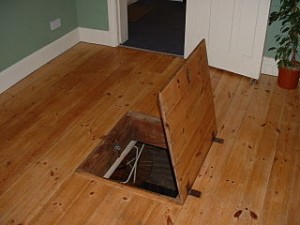 Print a Sign-In Sheet | Spanish Version
Print a Sign-In Sheet | Spanish Version
Unprotected holes in the floor, deck, or roof have resulted in injuries, and even fatalities, in the construction industry. Proper planning and personal attention, however, can prevent falls through openings.
- If you make a hole, guard it. Before cutting a hole, barricade the work area to keep people out.
- If the hole must be open, install permanent barricades around the perimeter. Like railings around the edge of a building or stairwell, barricades around a hole should be a minimum of 42-inches high, contain a mid-rail, and maintain the capability of withstanding a 200 pound load. Toe boards are recommended at all times and are required if anyone is going to work under the hole.
- If the hole is not guarded, it must be covered. The cover must be capable of supporting at least a 200 pound load, be larger than the opening, secured against displacement, and labeled “Floor Opening, Do Not Remove.” If possible, make a round hole and a larger round cover. An oversized round cover cannot fall through a smaller round hole.
- Never cover a hole with any type of non-substantial material, such as paper, cardboard, or plastic.
- Exercise extreme caution while walking over protective paper or plastic. A hole may be lurking underneath. Step very tentatively. If you find a hole, immediately expose it for others to see, barricade it, or post someone to warn others of the danger and immediately notify your supervisor. Even shallow holes can cause injuries.
- Plastic skylights and smoke vents are very popular. You should never stand or sit on a skylight. They are not made to support your weight. If installing skylights, protect the openings as described above until installation is complete.
KEMI does not assume liability for the content of information contained herein. Safety and health remain your responsibility. This information is to be used for informational purposes only and not intended to be exhaustive or a substitute for proper training, supervision or manufacturers’ instructions/recommendations. KEMI, by publication of this information, does not assume liability for damage or injury arising from reliance upon it. Compliance with this information is not a guarantee or warranty that you will be in conformity with any laws or regulations nor does it ensure the absolute safety of any person, place or object, including, but not limited to, you, your occupation, employees, customers or place of business.

